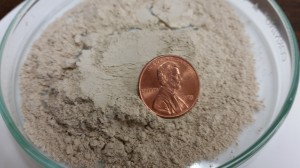Most everyone who is concerned with exploration and production of oil and gas resources has probably heard of the material, Barite. For those who have not, barite is chemically BaSO4 and forms commonly from depositional environments as well as processes such as biogenic, hydrothermal, and evaporation. The locations that are suitable for barite formation are typically in lead-zinc veins in limestone’s and hot spring deposits.
Drilling-grade barite typically is off-white to a light brown (figure 1). However, it can also be colorless, white, light blue, yellow, or grey. It is not a very hard material, and is a 3-3.5 on the Mohs Hardness Scale. It does however, have a uniquely high specific gravity for a nonmetallic mineral with an average of to 4.3-5. Both of these properties combined are what makes it so desirable to use in well drilling as a weighting agent in drilling fluid.
Figure 1: Image showing drilling-grade barite – Global Energy Laboratories
As a well is drilled and endeavors deeper and deeper, formation pressures become greater and greater. A danger of drilling is if the bit enters an area of pressure higher than the hydrostatic pressure formed by the drilling mud. When this first occurs, it is called a kick. This is the result of formation fluid entering the well bore. If not contained, the fluid will move up the well bore, forcing the material up and out. Should this fluid reach the surface, a blow-out occurs. Blow-outs can cause explosions due to high pressures and ignition of hydrocarbons found in the sub-surface.
To counteract this, barite is mixed into the drilling fluid to increase the density of the fluid and thus increase the hydrostatic pressure of the drilling fluid, keeping formation fluid at bay. With barite being a relatively soft mineral, it does not damage the bearings of the bit and is chemically inert. When looking to see if barite is suitable for drilling, four factors are tested:
-
The barite must have a specific gravity of 4.2 or greater. However, more recently, specific uses for barite with a specific gravity of 4.1 have been utilized.
-
Cannot contain any more than 250 milligrams of soluble alkaline salts, to make it chemically inert.
-
97% of the material by weight must pass through a 200-mesh (75μm) sieve screen.
-
Less than 30% of the material by weight that passes the 200-mesh screen must not be less than 6μm in diameter.
By John La Rue: Global Energy Laboratories Technician
Check out our other social media pages!

